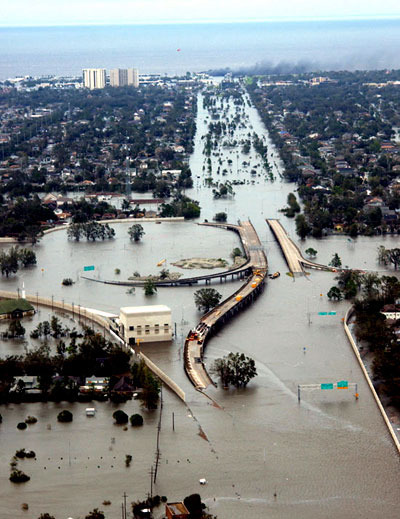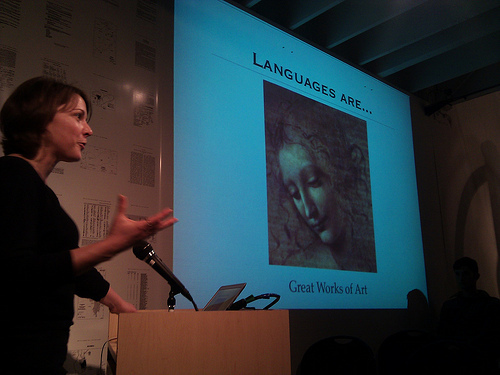Stewart Brand's Blog, page 105
March 25, 2011
Long Now Media Update

LISTEN
(downloads tab)
Matt Ridley's "Deep Optimism"
There is new media available from our monthly series, the Seminars About Long-term Thinking. Stewart Brand's summaries and audio downloads or podcasts of the talks are free to the public; Long Now members can view HD video of the Seminars and comment on them.







Soundscape Archives

This National Park Service spectrogram, from the Western Soundscape Archive, visually represents the sounds heard at a particular site over the course of 24 hours.
Sound is fleeting. Unless it is recorded while it occurs, it can never be heard again. As the earth evolves, species come and go, ecosystems change or are destroyed, and urban landscapes transform; when organisms and ways of life go extinct, their sounds disappear with them. We record music, lectures, and performances, but it is relatively uncommon to record our everyday activities and environment. There are, however, a few efforts to do just that.
High Country News recently published a profile of Jeff Rice, the founder of the Western Soundscape Archive. The archive hosts a growing collection of audio recordings of the flora and fauna of the Western United States.
The archive now represents close to 800 species — amphibians, reptiles, birds and mammals — even some invertebrates. Scientists, educators, students and nature enthusiasts can download podcasts or stream audio files free of charge. Rice sees the loss of species and habitats as a driving force behind his work. "We are experiencing a new 'silent spring' across the globe and in our own backyards," he says. "Not only is it a marker of what we're losing on an important ecological level, but it's also a loss of our heritage."
The collection also provides access to National Park Service acoustical monitoring. These take the form of spectrograms–images that show, over 24-hour periods, the relative prevalence of bird songs and airplanes, crickets and cars. They provide information about a region's biodiversity as well as the impact of anthropogenic noise on its ecosystems.
Aporee is another sound collection, but with a less specific sonic target. The aporee ::: maps project encourages people to record the sounds around them and upload them to the site. All recordings are plotted on google maps, where anyone can click on them to listen. The project is described on Aporee's website:
It develops from the insight that it is basically impossible to map the complexity of todays [sic] public spaces. Against the background of an increasing awareness of spatial aspects in media and the popularity and presence of visual geographies like google maps, the idea was to connect sound and space, and to create a cartography which focusses [sic] solely on sound, and open it to the public as a collaborative project. Meanwhile it contains 1000s of recordings from numerous urban, rural and natural environments, showing the sonic complexity of these environments, as well as the different perception and artistic perspectives related to sound, space and places. Furthermore, it's an exciting playground for experiments with sound and mobile media.
A sound archive could someday form a very engaging and informative part of a library dedicated to describing the human experience as it has evolved through time. Think of a museum exhibit on the ocean that includes short sound clips: rolling waves, the incessant squawking of seagulls, the call of an elephant seal. The portrayal instantly becomes more vivid, more real. For a future human to grasp what it meant to live in the 21st century, it could be quite useful to have a soundtrack with examples of car traffic, a busy farmer's market, or perhaps even the soft chirping and buzzing heard in a pine forest on a sunny morning, out of earshot from human civilization.
Click here to hear the Western Soundscape Archive's recording of a bark beetle (one species of which is responsible for the current epidemic that has killed vast swaths of trees in the Rockies).
Long Now's Alexander Rose recently visited the Svalbard Seed Vault with Steve Rowell, who uploaded to Aporee this recording of a Svalbardian windstorm. Make sure you've got a warm blanket with you.







March 24, 2011
Dynamic Wikihistory
A History of the World in 100 Seconds from Gareth Lloyd on Vimeo.
Thanks to Long Now research fellow Stuart Candy for sending this in:
Many wikipedia articles have coordinates. Many have references to historic events. Me (@godawful) and Tom Martin (@heychinaski) cross referenced the two to create a dynamic visualization of Wikipedia's view of world history. Watch as empires fall, wars break out and continents are discovered.
This won "Best Visualization" at Matt Patterson's History Hackday in January, 2011. To make it, we parsed an xml dump of all wikipedia articles (30Gb) and pulled out 424,000 articles with coordinates and 35,000 references to events. Cross referencing these produced 15,500 events with locations. Then we mapped them over time.
More information and datasets: ragtag.info/2011/feb/2/history-world-100-seconds/







Matt Ridley, "Deep Optimism"
Undeniable Progress
A Summary by Stewart Brand
Hominids had upright walking, stone tools, fire, even language but still remained in profound stasis. What led to humanity's global takeoff, Ridley argues, was the invention of exchange about 120,000 years ago. "That's ten times older than agriculture."
The beginnings of trade encouraged specialization and innovation, which encouraged further innovation, specialization, and trade, and the unending virtuous cycle of…
Read the rest of Stewart Brand's Summary here.







March 21, 2011
Danny Hillis remembers Richard Feynman at TEDxCaltech
At a TEDx event at Caltech in January, the theme was Feynman's Vision: The Next 50 Years:
TEDxCaltech was an unprecedented event that brought together innovators, explorers, teachers and learners for an exhilarating day of collaboration, conversation and celebration. We assembled a group of inventive thinkers and creative artists who are pushing the boundaries of their own disciplines. Throughout the day they introduced groundbreaking new ideas, shared inspired stories and gave us a glimpse at the technology of the future. Inspired by Caltech's own Richard Feynman, Nobel laureate, iconoclast and visionary, the day was an exciting and entertaining intellectual adventure!
At the event, Long Now co-founder Danny Hillis, who worked with Dr. Feynman while developing The Connection Machine, reminisced about becoming friends with the famously eccentric professor and relayed a conversation they had shortly before Dr. Feynman passed away. (Also see Hillis' essay on this story)







Long Quotes: Lenin
"There are decades where nothing happens; and there are weeks where decades happen". – Lenin
(thanks to @JPBarlow for this one)







March 16, 2011
Anthropocene arrives
Since the end of the last ice age a little over 10,000 years or so ago, human civilization has blossomed in a climatically friendly epoch known as the Holocene. The flowers are still blooming, but as climate change begins to mix things up some have been predicting that the story of recent and pending human history will prove quite dramatic…and it will be written in stone. National Geographic reports:
Stratigraphers like Zalasiewicz are, as a rule, hard to impress. Their job is to piece together Earth's history from clues that can be coaxed out of layers of rock millions of years after the fact. They take the long view—the extremely long view—of events, only the most violent of which are likely to leave behind clear, lasting signals. It's those events that mark the crucial episodes in the planet's 4.5-billion-year story, the turning points that divide it into comprehensible chapters.
So it's disconcerting to learn that many stratigraphers have come to believe that we are such an event—that human beings have so altered the planet in just the past century or two that we've ushered in a new epoch: the Anthropocene. Standing in the smirr, I ask Zalasiewicz what he thinks this epoch will look like to the geologists of the distant future, whoever or whatever they may be. Will the transition be a moderate one, like dozens of others that appear in the record, or will it show up as a sharp band in which very bad things happened—like the mass extinction at the end of the Ordovician?
That, Zalasiewicz says, is what we are in the process of determining.
Whether or not humans are ushering in such a singular moment in recent geologic history, there seems to be increasing support for the notion that we are leaving the Holocene behind, and that 'we' have enough to do with that transition to merit naming the new epoch after ourselves. The term 'Anthropocene' was first used by Paul Crutzen, a Dutch chemist, at a conference about ten years ago. It's come a long way: today it is featured in the March issue of the National Geographic.
Crutzen…thinks its real value won't lie in revisions to geology textbooks. His purpose is broader: He wants to focus our attention on the consequences of our collective action—and on how we might still avert the worst. "What I hope," he says, "is that the term 'Anthropocene' will be a warning to the world."
The photograph of the oil field above was taken by Edward Burtynsky, who spoke at our seminar series in 2008 on "The 10,000-year Gallery."







March 9, 2011
The 10,000 Year Storm

The Maeslant Barrier built for a once in 10,000 year storm
There was a maxim that predicted the existence of the longest living trees even before they were discovered, "adversity breeds longevity." Using this principle conifer scientists traveled to the harshest mountain peaks and found the Brisltecone Pine alive and over 4,800 years old.
It stands to reason then that a country that had spent the whole of it's existence defending itself from an encroaching sea, would have the longest term perspective on the subject. In 01939 when a series of studies in Holland revealed how their country might suffer from from a large storm in the north Atlantic, the Dutch began planning and building. Only part way through their efforts, a storm in 01953 proved them right, killing over 2,000 people and flooding hundreds of thousands of acres of farmland. Shortly after the flood these efforts would be doubled and put into a new nationalized government "Deltawerken" (Deltaworks) program. The Dutch have since been steadily building dams, barriers, and sacrificial flood areas. This culminated in the final Deltawerken project completed in 01997, the Maeslant Barrier one of the largest man made moving structures in the world. This barrier opens and closes over one of the busiest ports on the planet, and is strong enough to withstand a once in 10,000 year storm event. Yes, once in 10,000 years. At a cost of nearly $1 billion it seems unthinkable that a country could have this much resolve for such a rare event. In fact the barrier has already been closed multiple times and prevented minor flooding, so it is already paying itself off.
In the wake of Hurricane Katrina (considered a 100 year event) which killed over 1,800 people and cost more than $81 billion, it seems unlikely the US will build infrastructure like this to protect the Southeastern seaboard. I am not sure how much more adversity the residents of the gulf coast need however, they have had a tough decade. It could be that the culture in the US looks more to dealing with problems of the future with insurance rather than prevention. But if I lived in New Orleans, I think I would much rather have better levees and barriers, than a new insurance policy.

Devastation of Hurricane Katrina, a once in a 100 year event.







March 8, 2011
Are we ready to reach out to the stars?
SETI Director Jill Tarter discussed in a 02005 blog post that we recently discovered the possibility of broadcasting humanity's presence to the universe. SETI's position for at least the next decade is that we're not ready.
Any technology that is observable over interstellar distances cannot be more primitive than our own. After only 100 years of manipulating the electromagnetic spectrum, we find ourselves in the midst of an exponential explosion of technology. But it has taken us over 4.5 billion years of planetary and biological evolution to get to where we are today. If there is detectable technology out there, it is statistically improbable that their evolution and development will be fine-tuned to coincide precisely with our current emerging technological capabilities. They will be older, potentially billions of years older since the Milky Way Galaxy was around for at least five billion years before our solar system began to form.
In exploring some of the ways to make this decision, Tarter explains that communication across galactic distances will take protocols we can't imagine and timescales we're simply not seriously dealing with yet.
She searched Google and graphed the number of results she found for plans ranging between "The One Year Plan" to "The Two Hundred Thousand Year Plan." As a point of reference, the green arrow just below 10,000 hits on Google represents the number of results she found when searching for her own name. Plans over one hundred years in scope were most often the result of science fiction and religion, though Y2K and nuclear waste had lead to some longer plans as well. (Long Now is in there right next to the 10,000-year Yucca Mountain plan.)
I did a quick Google Book N-gram viewer search on some of these terms over the last hundred years and found that during the late '60s there was a peak in books discussing 'x year plans', the favorite being 10 year plans. 'One year -' and 'hundred year' plans show consistently, but few other plans registered at all.







March 7, 2011
Dr. Laura Welcher – The Rosetta Project & The Language Commons

Photo by Pat Tufts
Languages are works of art, great libraries, how-to guides for living on planet Earth, windows into our minds and inalienable human rights. Long Now's own Dr. Laura Welcher, Director of Operations and The Rosetta Project, spoke on March 3rd to a group of Long Now Members about the beauty, variety and value in the almost 7,000 languages spoken in the world. The event was part of our new Salon Series: occasional, intimate talks held in The Long Now Museum & Store for Members of the Foundation.
Laura's talk was called The Rosetta Project and The Language Commons and in it she discussed several efforts to preserve linguistic diversity around the world. The Long Now Foundation's role thus far, she explained, has been to develop and manufacture The Rosetta Disk: a durable, nickel archive of linguistic data. Laura also discussed her work with The Language Commons Working Group – a collaboration of linguists, archivists and programmers working to create an open and accessible encyclopedia of languages and linguistic diversity as a tool for teaching, studying, preserving and sharing languages.
The full audio of Laura's talk can be streamed from the player below or downloaded as an mp3. You can also click through the slides she presented in the window below the audio player.
Laura Welcher – The Rosetta Project and The Language Commons
View more presentations from longnow







Stewart Brand's Blog
- Stewart Brand's profile
- 291 followers








